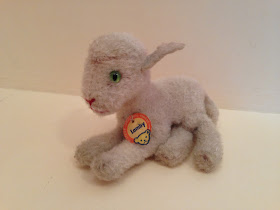Steiffgal: Niki, thank you for dropping by today. Clearly, given the holiday weekend, its a very busy time for you.
Niki: Yes, its the busiest time for sure! But I just wanted to thank all the Steiff fans out there for their interest and support over all these years. Steiff introduced my pattern in 1951... 62 years ago... and I have never stopped feeling the love. My family and I really appreciate that!
Steiffgal: It's safe to say that your design was so popular that it multiplied like jackrabbits. Tell us about that.
Niki: It is true that our original design and range in the Steiff line was "hare-raising." Some people even consider Niki rabbits to be one of the most beloved and collectible postwar Steiff patterns ever produced! I cannot argue with that. All of my relatives were made from tan or light grey mohair, had oversized brown and black pupil eyes, pink hand-embroidered triangular noses, and felt foot paw pads. We all also had really big feet - better to hop with, I guess. Larger Niki rabbits had mohair-lined ears and an open, peach-colored felt mouth, while the smallest Niki rabbits had pink velvet lined ears and a closed mouth, indicated by black embroidery. Overall, my family was produced by Steiff in 1951 through 1964 in 14, 17, 22, 28, and 35 cm.
Steiffgal: Steiff rabbits are a classic Steiff design, so much that they are given their very own chapter in Gunther Pfeiffer’s “Steiff Sortiment” books. It is also no surprise that rabbits appeared in the first printed Steiff catalog; interestingly, at least seven different rabbit designs were featured in this debut issue of 1892! Given all that history, you had mighty big legacy shoes to fill.
Niki: Yes, but we all jumped for joy at the challenge. Steiff gave Niki rabbits three really unique features that all but insured our blue-ribbon bunny status with collectors.
- The first is that we are all five ways jointed. This is exceptionally rare for Steiff rabbits. The vast majority of vintage Steiff rabbits are not jointed or simply head jointed. Five-way jointing is labor intensive and, in turn, quite expensive from a production standpoint.
- The second is that the larger Niki rabbits have open mouths. As far as my family-tree research reveals, we are the very first Steiff rabbits to be produced with an open mouth. This, of course, makes eating carrots much easier.
- And third, we have a distinct playfulness that is quite reflective of the era in which we were designed - the very early 1950's.
Niki: Thank you. Here's wishing everyone a 14 carrot gold holiday!

















